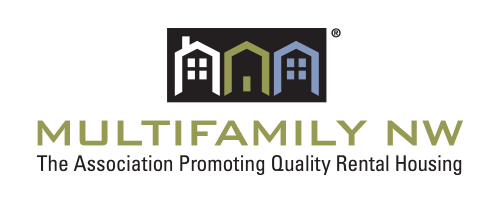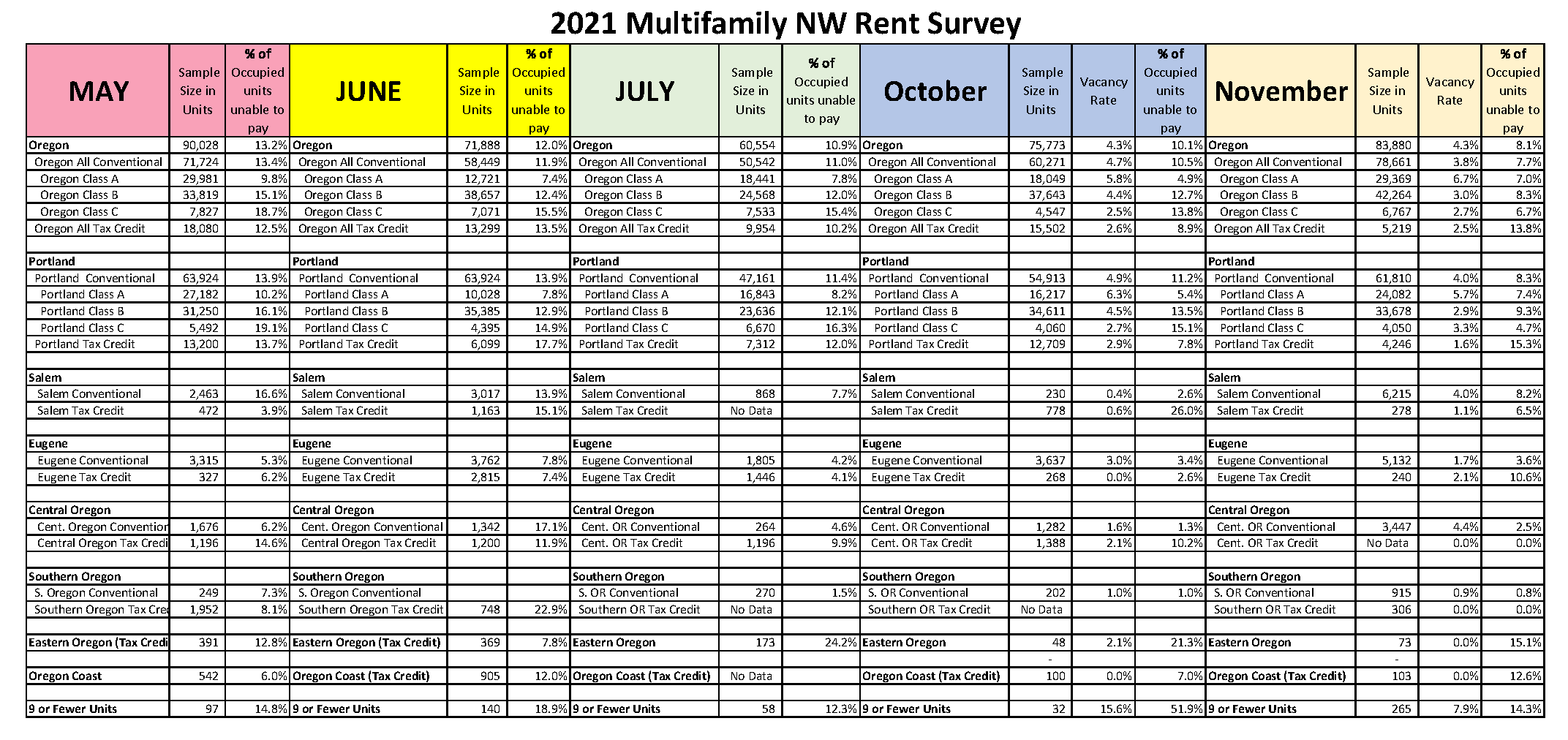November Rent Survey Results
Click image above to zoom in on data sets
Multifamily NW collaborated with a broad group of housing professionals (management companies, private managers, housing authorities, nonprofits, and state agencies) to collect surveys of conventional and affordable rental housing to track trends in ability to pay rent in occupied units across Oregon.
We did not survey the months of August and September. The survey collects data as of the 15th, and patterns of rent payment have been altered by Oregon legislation, with tenant rent payments continuing throughout the month and arrival of rent assistance being unpredictable.
Key findings for November:
- On average, 8.1% of Oregon households did not pay their rent by the 15th of the month, which represents a consistent trend of improvement since April: 14.1% in April, 13.2% in May, 12% in June, 10.9% in July, and 10.1% October.
- Statewide, conventional housing showed progress between October and November, improving from 10.5% to 7.7% nonpayment.
- The statewide Affordable Tax Credit units reported 13.8% inability to pay, however the sample size was much smaller with 10,283 fewer respondents in November than October.
- The most unexpected result in the survey was from the data collected on properties identified as “Class C.” Throughout the moratorium, this housing type experienced the more housing instability than other housing types, but in November they reported a dramatic improvement to 6.7% of their occupied units unable to pay rent.
Respondent Comments:
- The speed of processing is way too slow. It has been difficult for many of my residents- they don’t have access to a computer. It would be nice if the landlord could look up and see status easily. A clear definition of what each "status" represents on the sign in page would be nice. As a landlord I was sad to see large sums of money issued to people who didn’t do anything throughout the pandemic and many who consolidated and cut down were not taken seriously because they needed assistance with minimal amounts.
- Several people applying through multiple agencies and getting assistance in excess of allowable pre-paid amounts. We have had to go a month of back and forth with Mult. Co and Home Forward to finally get a response of "apply through 2/28/22 and return the rest) which is several months of rent to return for each resident. If the assistance programs all had a single server to review that showed when/where/if someone already applied elsewhere, I think this could avoid overpayments of this magnitude. And now we have residents mad at us because we let them know "we could apply 4 months but had to return the other X amount" and so they think we're just trying to screw them over when we're really just trying to make sure we do not get in trouble by accepting more than the allowable amount of government funds.
- The Portland laws are not making it almost impossible to continue to be a small property owner. I am seeking to sell all of my rentals in the next few years.
- We have 2 out of 20 that aren't paying rent for November but one 1 of the 2 is applying for assistance and the other has not responded to our manager.
- The amount of delinquent rent on the 15th was 2.8%. The ...units that did not pay Nov rent are mostly the same units that have a balance due from the protected period; they have not / will not apply for funds through OERAP or 2-1-1 although EVERY month, we politely ask them to do so.
- Approaching $40,000 in owed rent, some tenants aren't even trying.
- We have a handful that were not paying rent or had gotten many months behind on their rent. We are happy to say we only have one unit that is owing for a couple of months back but are paying on time. The other ones were able to get some kind of rental assistance that was offered during Covid and it finally came through to pay for their rents.
- Most of the residents that haven't paid rent are waiting for rent assistance to come through. Also the vacant apartments I have are from people who decided to get rent assistance to save money (not pay rent) so they can move out and rent a house.
- Most residents are making partial payments but not full amounts.
Most units are now on rental assistance or other state aid to pay rent. All tenants have new vehicles, boats, motorcycles, other expensive items. Some of the tenants have moved in other un-screened roommates and ignore violation notices or outright reply they saw on the news there's nothing landlords can do and admit taking advantage of the opportunity. - Of the 13 units not paying rent for November, all 13 are awaiting assistance payments that have awarded future months. Some units applied and were accepted as far back as July. More recent applicants are finding a wait that exceeds 6-12 weeks before an initial review has even been conducted. It is hard to truly gauge delinquency when rental assistance remains as incredibly sluggish as it has been.
- Our rentals are (Near Mt. Hood) -- no rentals available for ski lodge workers -- so many homes have converted to Vacation Rentals.
- Our residents are paying 100% on time. No delinquencies. They are work hard to do so, often with 2+ jobs, but they are paying their rent.
- Rent not received for September, October and November. I keep being told they cut a check for Sept and October, but they are waiting for funds to be available. Weird!
- Rental assistance checks take 6+ weeks to receive causing stress for residents and difficulties for staff
- Residents have applied for Rental Assistance but it is taking a really long time.
- Still very little communication/updates from OERAP. Would not matter at this point if the checks were actually received, but they are very slow coming.
- We have been fortunate through the COVID19. We worked closely with the tenants that needed assistance.
Note on Methodology:
The survey asks “How many occupied households were unable to pay full rent by the 15th day of the month?” The survey then adjusts for vacancy to arrive at the true percentage of occupied households that are unable to pay their full rent.
Definitions
Real estate professionals often use categories (A, B, or C) to describe rental properties after considering a combination of factors such as age of the property, location of the property, growth prospects, appreciation, amenities, and rental income. There is no uniform or precise formula for establishing these categories.
Class A - These properties represent the highest quality buildings in their market and area. They are generally newer properties built within the last 15 years with top amenities and demand the highest rent with little or no deferred maintenance issues.
Class B - These properties are close to Class A designation being generally older and typically offer fewer amenities. Rent is typically lower than Class A.
Class C - Class C properties are typically more than 20 years old and are not as well located. Due to a variety of factors, Class C buildings tend to have the lowest rent rates in the Conventional Housing market when compared to Class A and B properties.
Conventional Housing – Market-rate housing with no household income limits, rent limits, or special programmatic requirements in the financing.
Affordable Housing – Government financed housing (Often using Tax Credits or Bonds) that impose initial household income limits and maximum rent limits, all predicated on affordability calculations based on the area median income.
Thank you to every member and participant that took the time to complete the November Rent Survey that created these important data sets.

